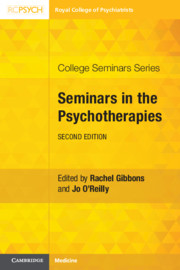Part II - Applied Psychotherapeutic Thinking
Published online by Cambridge University Press: 27 May 2021
- Type
- Chapter
- Information
- Seminars in the Psychotherapies , pp. 161 - 384Publisher: Cambridge University PressPrint publication year: 2021
References
References
References
References
* indicates highly recommended reading

